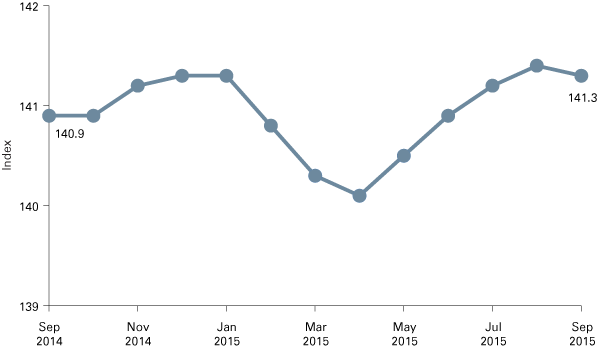Gary Forecast 2016
Assistant Professor of Economics, School of Business and Economics, Indiana University Northwest
2015 was not a strong year for the Northwest Indiana economy. In 2016, we will likely continue to see weak growth—between 0 and 1 percent. The region, however, has strong economic foundations and excellent potential for strong economic growth in the next decade.
Between September 2014 and September 2015, the Northwest Indiana economy grew by an anemic 0.3 percent, as measured by the Northwest Indiana Coincident Index.1 Figure 1 shows the Northwest Indiana Coincident Index over the last year. This index tracks the health of the Northwest Indiana economy (Lake, Porter, Newton and Jasper counties) and is published monthly by the School of Business and Economics at Indiana University Northwest. Over the same time period, based on similar indexes published by the Federal Reserve Bank of Philadelphia, Indiana’s economy grew 4.7 percent and the national economy grew by 3.2 percent.2
Figure 1: Northwest Indiana Coincident Index

Source: Indiana University Northwest School of Business and Economics
While economic growth for Northwest Indiana appeared promising at the start of the year, it was offset by several negative shocks. In February and March, monthly steel production fell by almost 15 percent in response to a strong U.S. dollar and weak international demand. In addition to this, the region is continuing to experience reduced employment in the construction industry, as well as weaker-than-expected employment in other sectors as part of an ongoing structural shift.
Table 1 shows employment levels in several key industries for Northwest Indiana in 2015 and 2004. While the overall level of employment has not changed significantly since 2004, the type of employment has shifted dramatically. Since 2004, the region has lost 5,800 jobs in the goods-producing sector (a 10 percent decline) and 4,400 jobs in the public service-providing sector (another 10 percent decline). During this same time period, this job loss was offset by large employment gains in health care/social assistance, food services/drinking places and retail trade.
Table 1: Trends in Employment for Northwest Indiana
| Sector | Employment | Average Hourly Wage in Indiana | ||
|---|---|---|---|---|
| 2015 | 2004 | Change | ||
| All Sectors (Total Nonfarm) | 278,100 | 278,700 | -600 | - |
| Goods-Producing | 52,600 | 58,400 | -5,800 | $25.42 |
| Construction | 15,500 | 19,400 | -3,900 | $27.03 |
| Manufacturing | 37,000 | 38,600 | -1,600 | $24.97 |
| Private Service-Providing | 188,700 | 179,100 | +9,600 | $21.90 |
| Retail Trade | 34,700 | 34,200 | +500 | $13.26 |
| Health Care/Social Assistance | 41,200 | 33,600 | +7,600 | $19.72 |
| Food Services/Drinking Places | 24,600 | 20,700 | +3,900 | $10.14 |
| Public Service-Providing | 36,800 | 41,200 | -4,400 | - |
| Local Government* | 29,900 | 34,600 | -4,700 | - |
* The subsectors of local government that lost the most employment were public schools and public hospitals.
Note: Employment changes greater than 1,000 are in bold.
Source: U.S. Bureau of Labor Statistics, Current Employment Statistics
While the overall level of employment for the region has remained steady between 2004 and 2015, this ongoing structural shift away from goods-producing jobs (such as construction and manufacturing) toward private service-providing jobs (such as retail and food service) has had serious implications for household earnings.
Table 2 shows average annual earnings for Northwest Indiana, the state of Indiana, the greater Chicago area and the United States overall. Between 2012 and 2015, the average employee in Northwest Indiana experienced a $2,570 pay cut (a 6 percent decline), reflecting the shift from goods-producing jobs with higher pay and better benefits to service-providing jobs with lower pay and fewer benefits. Over the same time period, earnings at the state and national level increased by a similar amount. In the greater Chicago area, annual earnings rose by more than $3,500 (a 7.9 percent increase).
Table 2: Trends in Average Individual Annual Earnings
| Year | Northwest Indiana | Indiana | Chicago Area | United States |
|---|---|---|---|---|
| 2012 | $42,581 | $37,087 | $44,580 | $40,521 |
| 2015 | $40,010 | $39,762 | $48,096 | $43,044 |
| Dollar Change | $-2,570 | $2,675 | $3,516 | $2,523 |
| Percent Change | -6.0% | 7.2% | 7.9% | 6.2% |
Source: U.S. Bureau of Labor Statistics, Current Employment Statistics
One of the major reasons for the decline in goods-producing jobs (and subsequently the decline in average annual earnings) for the region was the construction industry. One of the driving forces behind the loss of construction employment was the completion of the BP-Whiting refinery project, a $4.2 billion upgrade, which employed over 14,000 skilled trades workers at its peak. The project was completed by the end of 2013, and between 2012 and 2015, the number of man-hours in union construction in Northwest Indiana fell by more than 68 percent.3
While in the short-term, this dramatic decline in construction has reduced average income for the region, construction employment is likely to expand again in the future with a number of major projects either just beginning or on the near horizon.
- In 2015, Indiana University Northwest began constructing a $45 million Arts and Sciences academic building, one of the largest non-manufacturing new construction projects in Gary in the last few decades.
- The Indiana Department of Transportation is anticipating more than $320 million in state and local highway projects in 2016, with another $189 million in projects in 2017.4 The Northern Indiana Public Service Company (NIPSCO) is currently undergoing a number of expansion projects and expects some larger projects next year as well.
- The Illiana Expressway, the controversial toll road extending from Northeast Illinois to Northwest Indiana, is slowly moving ahead after being stalled for many years.
- The West Lake Corridor extension of the South Shore Commuter Line, which is expected to cost between $570 million and $615 million, is currently undergoing an environmental impact review and is expected to enter the project development phase in 2016 with construction beginning in 2020.5
In addition to these projects, between September 2014 and September 2015, the total number of new residential housing units built in Northwest Indiana increased by 50 percent, and the average cost of construction per unit fell by 24 percent.6 All of these signs suggest the possibility of a strong resurgence in construction for Northwest Indiana.
Forecast for 2016
In addition to providing a measure of the current economic health of the region, the Northwest Indiana Coincident Index also forecasts growth in the regional economy and regional employment in the upcoming year. Table 3 shows the forecast for 2016, along with forecasted and actual growth in 2015.
Table 3: Northwest Indiana Regional Forecasts
| 2015 Forecast | 2015 Actual | 2016 Forecast | |
|---|---|---|---|
| Economy | +2.2% | +0.3% | +1.0 |
| Employment | +0.7% (+2,000 jobs) | +1.1% (+2,900 jobs) | +0.4% (+1,100 jobs) |
Source: Authors calculations, using Northwest Indiana Coincident Index data
In 2016, the Northwest Indiana economy is forecasted to grow only 1.0 percent, with regional employment expanding by only 0.4 percent (or the addition of approximately 1,100 jobs). While any economic growth and job expansion is a positive sign for the region, growth at this rate would still leave the region approximately 9,800 jobs (or 28 percent) below the pre-financial crisis employment high in 2007. In addition, this growth is likely to be slower than the economic growth for both Indiana and the nation overall.
Notes
- The Northwest Indiana Coincident Index is released monthly at http://go.iu.edu/nwi.
- United States Coincident State Index, Federal Reserve Bank of Philadelphia
- Source: Construction Advancement Foundation (CAF) data
- Northwestern Indiana Regional Planning Commission (NIRPC) Transportation Improvement Program (TIP) Report, FY 2016-2019
- Northern Indiana Commuter Transportation District (NICTD) West Lake Corridor Project (www.nictdwestlake.com/)
- U.S. Census Bureau Monthly Residential Construction Permit Database




